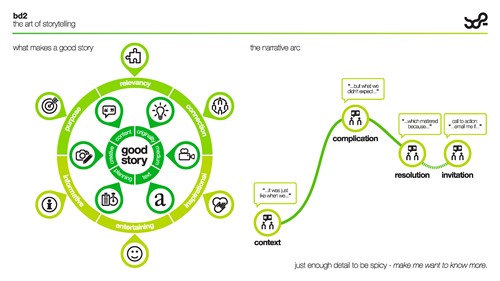We’ve blogged many times about the benefits and principles of a content marketing and a storytelling approach encapsulated in the oft repeated advice about ‘telling not selling’. This is because we all like to listen to or read stories rather than lectures as they’re typically much more engaging, they hold our attention and they gently lead us towards a conclusion – hopefully a ‘happy ending’ about the benefits of our product or service. Obviously we’re not all as good as telling stories Hans Christiansen Anderson, Shakespeare or Stephen King of course, otherwise we’d no doubt be doing it for a living! Here’s our hints and tips on what makes a good story, encapsulated in the infographic.

- Relevancy we enjoy stories we can relate to, so create context or a scenario that’s relevant to the target audience which is generally fairly obvious for a business operating in a specific market sector.
- Purpose we all appreciate stories that deliver a message and have a clear intent
- Informative naturally a story that includes important or enlightening information is going to be well received.
- Entertaining even in B2B situations there’s generally no reason why the story can’t be entertaining and a little humour never goes amiss, as long as it doesn’t undermine your authority.
- Inspirational stories that we can draw inspiration and get ideas from are always positive.
- Connection as well as relevancy, stories that help us feel included in an experience and that we can connect with, will always resonate.
It’s also important to consider the elements related to the content and themes to attract the reader that highlight and illustrate the story or key points which will help how well it will be perceived - it's just like the cover of a book or the photography or illustration alongside a magazine article, these include:
- Originality new and original content is very strong as it adds authenticity and demonstrates experience and knowledge.
- Medium imagery, such as photos or diagrams, always help to illustrate a story, but video really brings it to life.
- Text this is largely determined by the chosen medium, so video might not have any text – although we always recommend captioning - but a blog post may be mostly or all text.
- Planning consider the structure and length of the piece, which is obviously affected by the subject matter as something complex or technical might need a lot of explanation. Sometimes it’s better to handle detail in a separate document and use a blog post to summarise it with a link to download and then use social medial posts for the highlights that would attract the reader to the post.
- Creative elements Stories that use imagery such as photography, illustration and infographics are more enjoyable and videos that use effects, animations and transitions again are more engaging.
The most enjoyable and relatable stories portray at least one of these criteria, sometimes several, and they generally use imagery to engage the reader. With video the imagery may well tell parts the story, along with the script or dialogue. When the story works, on any of these levels, then it gets shared across social media and the potential viral benefits and extended reach can really be reaped.
The story arc is an established structure that works well, especially in a B2B context, and it also helps when faced with that blank sheet or paper or screen. Start by setting the scene "...it's just like when.." then introduce a complication or issue "...what we didn’t expect was..." and then finish with the resolution or benefit that demonstrates your expertise "...why that mattered was..." For example;
The most enjoyable stories are primarily defined by being visual and entertaining. Second, is the relationship to the person who shared the story. Users also appreciate stories that are inspirational, original, about an interesting topic, and a good length. Research by AI Lab shows that of the various content elements, the most important is the inclusion of visuals, followed by the originality of the content and the length of the story, and finally, least important are a narrative structure and unique effects:
“Even though the content of the story is important to enjoyment, certain content elements are far more important than others. Of the various content elements, the most important is the inclusion of visual elements, followed by the originality of the content and the length of the story, and finally, least important are the narrative and inclusion of unique effects. This suggests that while we should consider content, different content elements need to be evaluated separately and given different weight in ranking models and development plans. The same is true for relevance — the relationship to the creator is more important than the topic of the story. It is therefore important to consider the different elements on their own as opposed to making ranking/investment determinations based on the general category.”
In summary, if you want to deliver good stories on your website, blog or any of the various platforms you publish on, the focus should be in increasing your investment in visual stories, whether that’s video or imagery. Then, promote them heavily to maximise that investment which may be in your own time or it may include third party content creation specialists, subject to your resources and budget. Continue to include the relationship to the creator as it's an important element for ranking. Last, but not least, make sure you do your research, that’s both as part of the creation process, but also to measure what was well received in terms of likes, shares and feedback or comments. This knowledge will help you understand what makes a story more and less engaging so that you can refine your approach.

